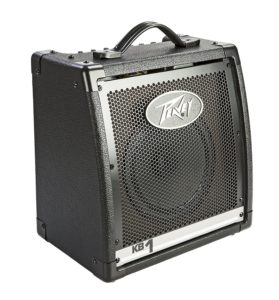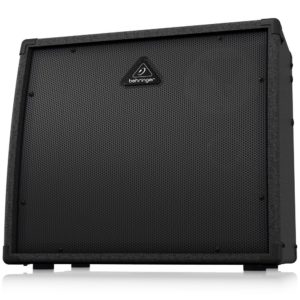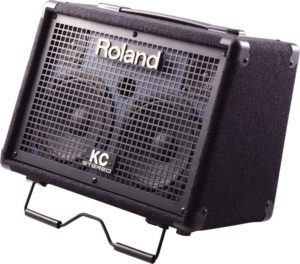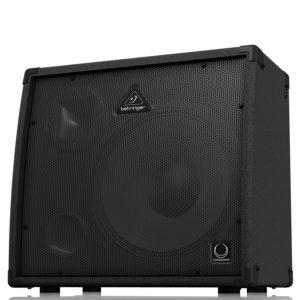Are you looking for the best keyboard amps under $500? Then, you’re in the right place.

Electronic instruments provide the keyboardist with a wide range of new options for producing their desired sounds. Furthermore, they are often more portable than their “grand” and even “baby grand” counterparts and, in some cases, have no issue sounding nearly as good.
As an electronic guitar, the central issue is that it often cannot produce enough sound independently. So the trick is, how do you find that amp with a perfect balance between sound quality and projection at a fair price without sacrifice?
That is always the question! Read on to find out which is the best keyboard amp under $500!
Top 4 Best Keyboard Amps Under $500:
| Image | Model | Price |
|---|---|---|
 | Peavey KB1 (Top Pick) | Check Price |
 | Behringer Ultratone K900FX | Check Price |
 | Roland KC-110 | Check Price |
 | Behringer Ultratone KXD12 | Check Price |
Peavey KB1 20W Keyboard Amplifier (Editor’s Choice)
The Peavey KB1 is the minimalist of the list here.
While it is very light on features, it is one of the two amps on this list, specifically designed for use with keyboards. While that may not matter to all buyers, some will say that the only amp used with a keyboard is a keyboard amplifier. That would disqualify the previous two amplifiers on the list.
If you are looking for a portable, keyboard-specific amplifier for practice, I do not think there is a more sensible option on the list than the KB1.
The KB1, while very light on added features, is also simple and effective. From some perspectives, the simplest solution is also the best. There are very few things that you have to fiddle with on the amplifier to get quality sound.
The KB1 features two channels with a 2-band EQ on each. It also has a headphone out. The 8″ speaker is more than enough for small gigs (coffee shops, solo piano in a small bar) and practice.
Pros
- Simple and effective
- Ultra-portable
- Few choices lead to more reliable sound
Cons
- Very few additional features
- Limited due to size
Behringer Ultratone K900FX Keyboard Amplifier
You would not be remiss, considering this amplifier the “little” brother of the previously reviewed KXD12. The little brother here actually makes several improvements to the amplifier while keeping some of the essential aspects.
The first thing is that the amplifier is a much tamer 90 watts. I think that this is much more of a “sweet spot” than the 600 watt KXD12. That allows you to crank the amp a little during practice and still have enough control and juice for a larger venue. What you do miss, if it matters, is the bi-amplification technology in the KXD12.
A number of the other features on this amplifier tick the “essentials” boxes:
- 3 Channels with separate FX sends
- Good digital FX modeling
- 5-band graphic EQ for optimal sound modeling
- “Main” adjustments for volume
- Sub-woofer output
Pretty much everything you need is contained in the long list of features from the manufacturer.
What is most interesting about this amplifier is the price: about $250 at the moment of writing. Admittedly, that is much less than its big brother or the Roland KC-110. However, even at a lower price, I think that the K900FX ticks all the necessary boxes to be a decent amplifier for keyboard players.
Pros
- Lightweight and portable
- Good volume output
- Ticks all the essentials at a low price, maintaining quality
Cons
- Not great at a single thing
Roland KC-110 3-Channel Keyboard Amplifier
Clocking in at an excellent 30 watts, the KC-110 offers a nice feature set under the $500 mark.
Interestingly, the amp focuses so strongly on portability that it can get its power from 8 AA batteries or AC power at home.
That focus on portability first comes through in the efficiency of the speaker configuration as well. The amplifier features 2 6.5″ speakers and 2 1″ tweeters offering a full stereo setup that is powerful and portable.
Most reviewers state that the amp can also reach reasonably far with the settings tuned upright for the room. That means that not only is this a portable and lightweight amp, but it does not pull any punches when it comes to packing decent power enough for a gig or two during the week, along with practice sessions.
The KC-110 also features three distinct channels with several effect settings options for each. It also includes a single XLR input and two stereo inputs, a stereo AUX input, stereo outs, and headphones.
The amp covers all of the bases for a portable, battery-powered amplifier.
Pros
- Good sound
- Respectable volume when desired
- Lightweight
- Optional battery-power setup
Cons
- On the smaller side
- Lower wattage
- Only one instrument line-in
Behringer Ultratone KXD12 Keyboard Amplifier
The KXD12 is much different than the Roland KC-110. However, the KXD12 is a beast within this price range.
The first thing to note about the KXD12 is its hugely powerful amp at 600 Watts on each channel. Additionally, Behringer claims it is a “true bi-amplifier design,” which means that one amplifier powers the woofer and the other powers the mid and tweeters. That means that you can get a ton of sound because two amps are working together.
Behringer also states that this amplifier could also be used as a PA system. While most reviewers believe it is much better suited and, in fact, wasted as a PA system, you could use it as such. But, I think you would be missing out on one of the truly great piano/keyboard amplifiers in this price range.
The speakers in this thing are very respectable TURBOSOUND speakers, no real complaints, and nothing to write home about. What you get with this amp is a vast yet lightweight workhorse.
Also, the amplifier features some effect presets for you to choose from, thanks to the Klark Teknik FX processor inside.
Pros
- Fairly advanced technology in the sub-$500 range
- Massive, yet relatively lightweight
- Loud
Cons
- Okay speakers
- Loud
- Not as portable as other amplifiers on this list
How to Find the Best Keyboard Amp
Features To Watch Out For
For most amplifiers, you must consider what kind of sound you want to get out of it. Thankfully, for keyboard amplification purposes, a more standardized sound is often in order. That means trying to find an amp is made both a little more complicated and a little easier. On the easier side, we do not have to consider the advantages of tube amplifiers for guitars. On the other hand, a tube amp for a keyboard would not provide that much tonal benefit. On the more difficult angle, there are a lot more choices.
Hopefully, by providing a list of essential features, we can narrow down the selection of amplifiers.
Wattage
Often, one of the fundamental factors differentiating one amp from another is the wattage.
A fundamental and almost dangerously reductionist rule of thumb to consider goes as follows “the higher the watts, the louder the amp.” Of course, this takes the complex equation and makes it very basic, but this is a rule to start from for most practical considerations.
When comparing keyboard amps below $500, you want to ensure that you get something versatile enough for playing gigs but not so loud that practicing becomes difficult.
The question you want to ask yourself is this, “How much power do I need?” Amps like the Leslie amplifiers for the B3 organs are 200 watts, which is quite a healthy wattage but probably unnecessary for a small-time gigging musician. If, on the other hand, you plan on playing huge venues, the Roland KC-880 clocking in at 320 watts might be something for you to consider because of its power output.
If I were to recommend a wattage, I would say stick between 50 and 150 watts for most applications. Going any large is getting far outside this price range and far outside what is practical for a regular person.
Speakers
When talking about amps, one of the more important aspects is the speaker system contained therein. The most important features to note are the size of the speakers and the quality.
You want to make sure that you pick a speaker to provide the best volume output for your needs in terms of size. If you buy an amplifier only for practice, you probably do not even need one with speakers. Only something to plug headphones into would suit you very well, especially if you do not live or practice in a private place where noise will not disturb anyone else.
I like to look for speakers made by well-known speaker manufacturers for obvious reasons in terms of quality. In addition, the more experienced a manufacturer is (hopefully), the more reliable their products are.
A further consideration within the speaker realm is the speaker configuration. Perhaps a keyboard amplifier’s most common speaker configuration is a 12″ woofer paired with a 1″ tweeter. That makes it so the amplifier can accurately render sounds across the entire frequency response spectrum.
A 12″ woofer and a 1″ tweeter of good make and model will provide the most cost-effective setup at the $500 price point.
Frequency Response Range
The keyboard is one of the select few instruments often called up to cover the frequency response range’s entirety. Simply put, the keyboard can easily accomplish bass, rhythm, harmony, and lead playing without batting an eyebrow.
To provide good sound quality, you want to ensure that your amplifier has a wide enough frequency response range to accurately render the keyboard’s sound across the whole sound spectrum.
It is the fundamental reason you will often hear recommendations against using guitar or bass amps for keyboard amplification.
Portability
If you are a gigging musician, you often have to tow the line between power and portability. Keyboard amps are no different.
I think the best way to gauge the right amount of portability is to go and try to lift the amp you are considering buying.
Portability does not have to be a concern for someone who is only buying a practice amplifier. However, if portability is a concern, make sure you understand how feature additions affect your amplifier’s portability.
Effects
Something that you might also want to consider is what kind of keyboard playing you are doing. For example, if you are doing something that requires a lot of sound shaping and effects, you need to consider each prospective amplifier’s effects capabilities.
Most amps give you a bit of a choice: Do you want to adjust the effects manually? Look through presets made by “experts”? Or a little of both? Being in the market for a keyboard amplifier means that you have to know what sort of effect capability you want your amplifier to have.
Effects may not be necessary if you have a keyboard to do all of that for you. If that is the case, then maybe looking for an amp with little to no effect capability is the right choice for you. On the other hand, if your keyboard is more bare-bones, you might need some effects assistance from the amplifier.
Wrap-Up: What’s the Best Keyboard Amp Under $500?
The best keyboard amplifier under $500 for the gigging musician is the Roland KC-110. The 30-watt design gives enough power to push it a little in larger gigs, and the sound quality is excellent.
If you are looking for something slightly less and more portable, the Peavey KB1 is one to consider. Its price (under $200 at the moment of writing) is incredible for such a good keyword amplifier.
The two Behringers on the list are also great amplifiers, but they come from a design made for more than just keyboards. So if you are looking for an amp and have no qualms about whether or not they are “keyboard specific,” they are great amplifiers in this price range.